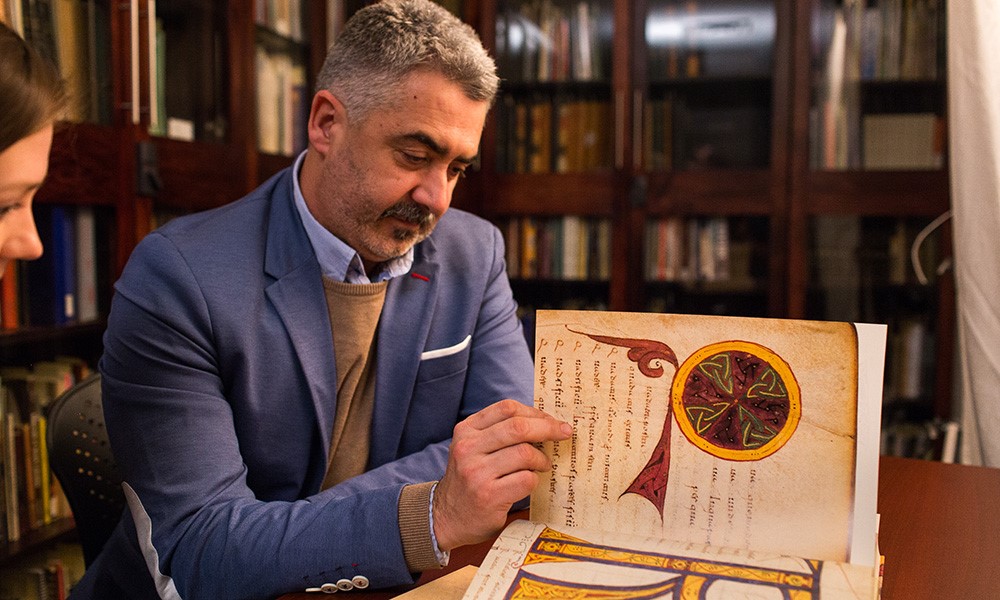Project receives more than $2.1 million in federal funding

UBCO’s Dr. Francisco Peña is leading an international team that will translate and digitally preserve the General e grand estoria—the largest universal history written in Medieval Europe.
One of the world’s most unique and important texts, the General e grand estoria (GE), will soon be translated, analyzed and made widely available, thanks to a global endeavour being led by a UBC Okanagan researcher.
Dr. Francisco Peña, Professor in the Faculty of Creative and Critical Studies, is leading a team of international scholars in the collaborative effort to translate and digitally preserve the General estoria—the largest universal history written in Medieval Europe.
The project was awarded more than $2.1 million through a Social Sciences and Humanities Research Council (SSHRC) Partnership Grant, announced today by the Honourable Mélanie Joly, Minister of Industry and Minister responsible for Canada Economic Development for Quebec Regions, as part of a larger funding announcement for Canadian university research that included more than $9 million for UBCO research.
“While this is one of the world’s most unique and important texts, it is unfortunately not widely known,” says Dr. Peña. “Many relevant texts written in medieval Spain have disappeared. Through our efforts, we hope to change that fact and preserve this valuable piece of literature forever.”
The GE was commissioned by Alfonso X of Castile, who ruled Spain from 1252 to 1284. It was an effort to record the entire history of humanity, from the origins of the world as narrated in the Bible up to the time the work was commissioned.
Written in Spanish, the GE is unique in several ways, explains Dr. Peña. It’s the first work of its type in a language other than Latin, and it includes the social and cultural history of the world to that point in time, not just the political history. It’s also noteworthy that its authors spanned multiple religions. While many texts of the time were commissioned and written by Christians alone, the GE’s authors included Christians, Muslims and Jews.
It totals more than 6,000 pages, and is an integral piece of Spain’s history.
Dr. Peña will oversee the project along with project co-directors, Dr. Katie Brown from University of Exeter in England and Dr. Francisco Gago-Jover from the College of the Holy Cross in Worcester, Massachusetts.
The project team includes 55 scholars and practitioners from 18 partner organizations across Canada, the United Kingdom, the United States of America, Spain, Portugal, Egypt, Colombia and Tunisia.
In addition to translating to English, the team will be annotating and analyzing the translated text to aid in explaining it to a lay audience.
“The text hasn’t been well understood to date because it’s impossible for a single scholar to tackle a project like this with its size and complexity,” says Dr. Peña. “So, we’ve assembled this team from across the globe to tackle it together.”
They’ll be using a digital platform called Colabora that Dr. Peña developed with colleagues in 2018, using funding from a previous SSHRC grant, to transcribe, digitize, translate and annotate the original GE text. During this latest project, he hopes to be able to train Collabora’s AI components to read the 13th century handwriting to speed up the document’s transcription.
The original text is housed at the Biblioteca Nacional de España, and part of the $2.1 million will be used to provide graduate students with a number of experiential learning opportunities working alongside the original 13th century document in Spain.
“In the spirit of how the original text was written, we want to create a network of students from many countries and cultures and give them opportunities to work and study together at the same time. This is an invaluable opportunity for us to provide training and experience they can’t receive any other way,” says Dr. Peña.
The team also plans to create a series of additional materials to help lay audiences understand the original work and will partner with libraries and school districts in North America, Europe and North Africa to help disseminate the information.
Connecting with a general audience is a huge component of the project, says Dr. Peña.
“In the last few years, there’s been a mistrust of academic institutions—a perceived distancing of universities from non-university communities. We want to bridge that gap,” he says. “This document was written in the language of the people—there was an aim to reach as many of them as possible. We’re going to do exactly the same thing.”
The Canadian government’s willingness to support the work of preserving a Spanish document is unique, says Dr. Peña.
“I love that Canada has stepped up to do this for something that’s not Canadian. To help preserve history, reach and connect people from different cultural backgrounds, and spread knowledge,” he says. “This may be a Spanish text, but the values—that’s what’s Canadian.”